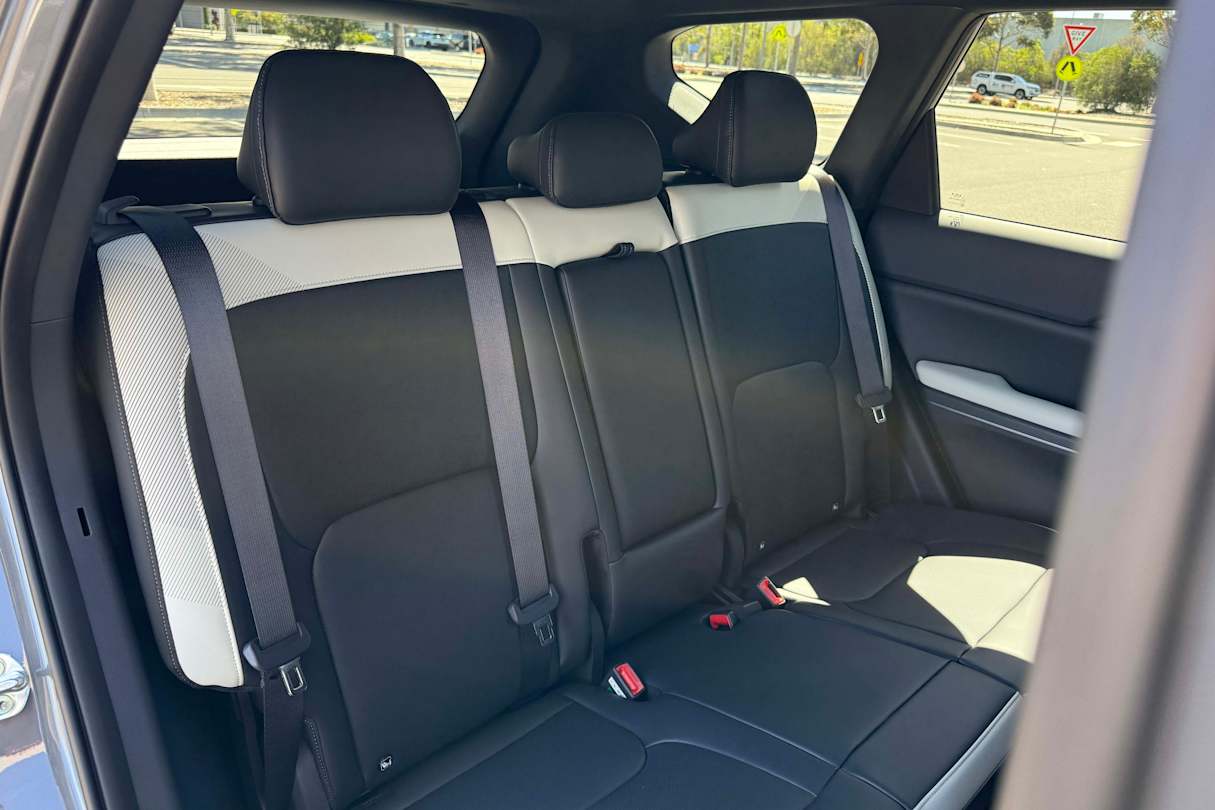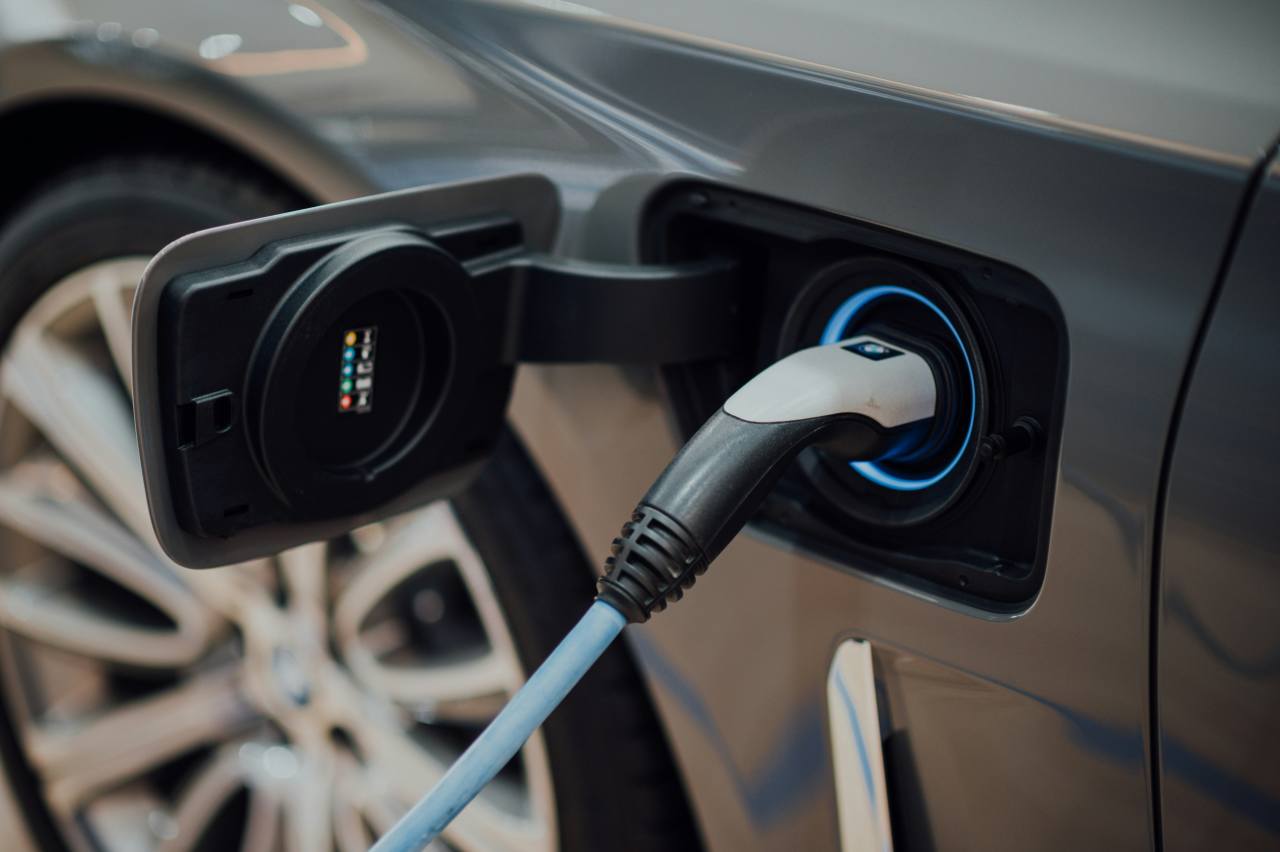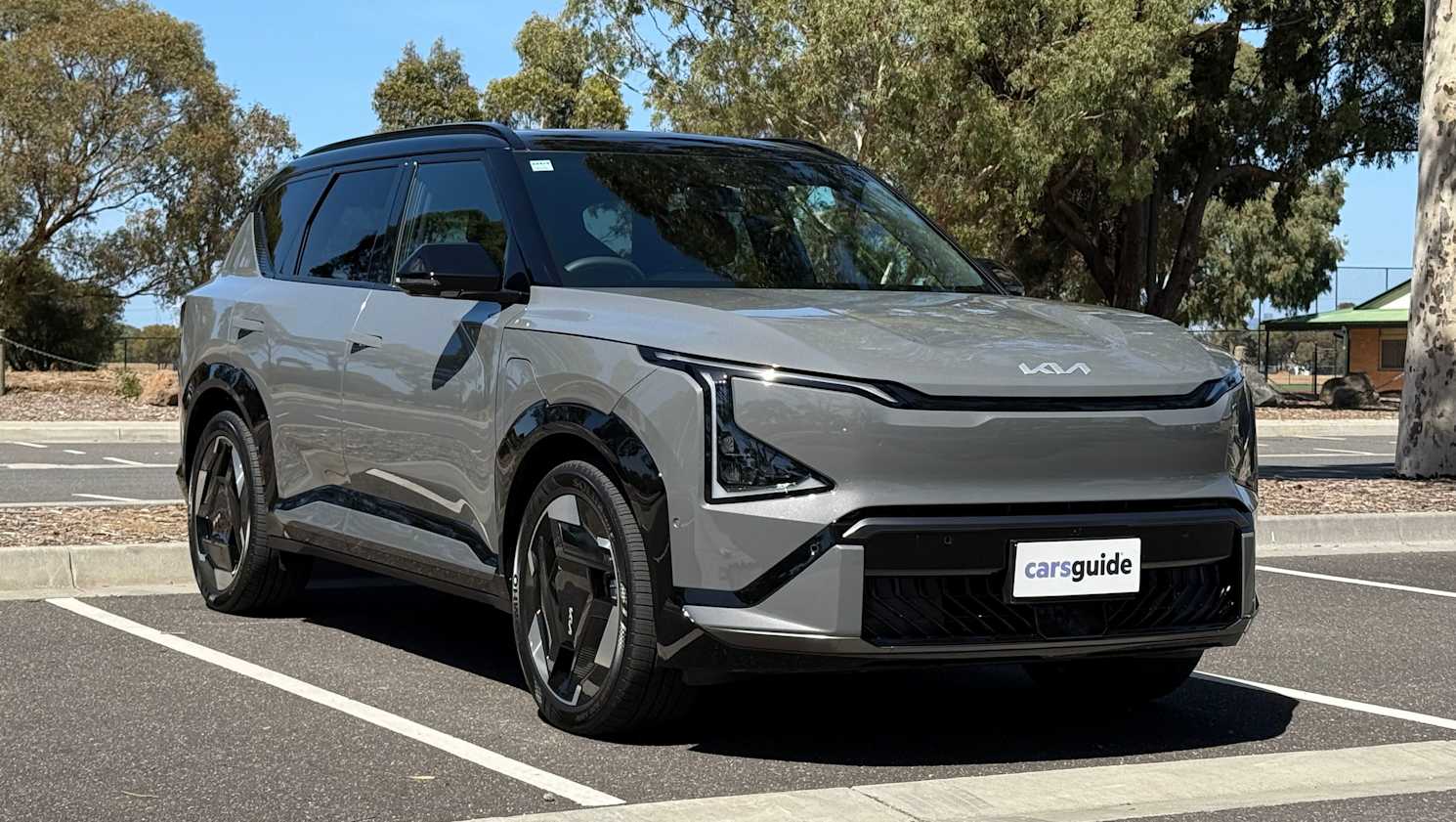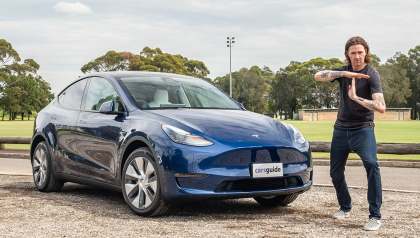The 2025 Kia EV5 is here to achieve one goal: to outsell the Tesla Model Y.
Now, that’s no mean feat, as the Model Y has been Australia’s best-selling fully electric mid-size SUV – and by some margin – since it arrived here in August 2022.
But the EV5 is looking to shake up the establishment with its sharp drive-away pricing and longer list of standard equipment, including some critical additions. Plus, it also arguably has a much more attractive exterior design.
Either way, following the EV5’s local launch in October 2024, Kia has added a new GT-Line flagship to the line-up, which offers EV buyers the best of the best when it comes to goodies.
So, we’ve got the keys to a GT-Line for the next three months to find out how well the range-topper stacks up in the real world.
Point being, does the EV5 deserve to outsell the Model Y, which has a major facelift arriving imminently?
This three-part EV Guide long-term review will attempt to answer that very question, with this first instalment dedicated to the EV5 GT-Line’s pricing, features (including powertrain and safety) and ownership credentials, plus my first test of its real-world efficiency.
Next month’s second chapter will deep-dive the EV5 GT-Line’s exterior and interior designs, as well as its practicality, while June’s third and final entry in this series will be headlined by my driving impressions and final verdict.
So, let’s get to it, shall we?
Priced (and specced) to compete
The first Chinese-built Kia model, the EV5, is available in three grades, with the entry-level Air offered in Standard Range and Long Range variants, priced from $56,770 and $63,990 drive-away respectively.
Then there’s the mid-range Earth and fully loaded GT-Line, which is only offered in Long Range form, at $68,990 and $75,990 d/a (or $71,770 before on-road costs) respectively. It’s worth noting the Air and Earth cost $1000 more in Western Australia, while the GT-Line is $2000 pricier. Sorry, WA.
Either way, the EV5’s pricing measures up very well when compared with the upcoming Model Y. The latter’s new full-time line-up starts with the Rear-Wheel Drive, at $58,900 plus on-road costs, while the mid-spec Long Range All-Wheel Drive costs $10,000 more. The top-of-the-tree Performance hasn’t been revealed yet, let alone priced.

Of course, the EV5 is facing more competition than just the Model Y, as it’s arrived at a time when Australia is receiving a deluge of new Chinese car brands and their models, most of which are also fully electric mid-size SUVs so far.
These newcomers include the very keenly priced Geely EX5 ($40,990) and Leapmotor C10 ($45,888), as well as Deepal S07 ($53,990) and XPeng G6 ($54,800).
Then there’s also the usual suspects like the Volkswagen ID.4 ($59,990), Ford Mustang Mach-E ($64,990), Toyota bZ4X ($66,000), Hyundai Ioniq 5 ($69,800), Subaru Solterra ($69,990) and Skoda Enyaq ($69,990). All of those starting prices are before on-road costs. Now, deep breath.

But there’s more to the EV5 than just its keen pricing, as it also offers buyers a very, very long list of standard equipment, no matter the grade.
The Air generously kicks things off with dusk-sensing LED lights, rain-sensing wipers, 18-inch alloy wheels (with a tyre repair kit), power-folding side mirrors with heating, roof racks, keyless entry and a rear spoiler.
Inside, keyless start, a 12.3-inch touchscreen multimedia system with over-the-air updates, satellite navigation, digital radio, Bluetooth, a six-speaker sound system and wireless Apple CarPlay and Android Auto support.

There’s also a 5.0-inch touchscreen dual-zone climate control panel, a 12.3-inch digital instrument cluster (something the Model Y sorely needs), an eight-way power-adjustable driver’s seat with three-cell massage functionality, heated front seats, an auto-dimming rearview mirror and cloth and artificial leather upholstery.
Advanced driver-assist safety systems are expansive, including autonomous emergency braking (AEB) with pedestrian and cyclist detection, and junction assist.
Then there’s also adaptive cruise control with stop and go functionality, lane-keep and -change assist, steering assist, speed-limit assist, blind-spot monitoring, active rear cross-traffic alert, driver attention monitoring, high-beam assist, tyre pressure monitoring, a reversing camera, front and rear parking sensors, safe exit alert and rear occupant alert.
You also get seven airbags, including dual front, side and curtain, plus a front-centre. All of these inclusions helped the entire EV5 line-up get the desired maximum five-star safety rating from ANCAP, according to its 2024 protocol.
In addition to its dual-motor powertrain (more on that in a moment), the Earth adds 19-inch alloy wheels, rear privacy glass, a power tailgate with kick-to-open functionality, and artificial leather upholstery.
And the GT-Line on test here goes several steps further with dynamic indicators, 20-inch alloy wheels, auto flush door handles, Active Sound Design (driving sounds), a panoramic sunroof with a sunblind, an eight-speaker Bose sound system, an augmented reality (AR) head-up display (another thing the Model Y could benefit from), a wireless smartphone charger and fingerprint authentication.

It also gets a sports steering wheel with heating, a relaxation driver’s seat with a two-way power-adjustable leg rest and six-cell massage and two-position memory functionality, a four-way power-adjustable front passenger seat with three-cell massage functionality, cooled front seats, heated outboard rear seats, two-tone synthetic leather upholstery, 64-colour ambient lighting, alloy sports pedals and a heated and cooled rear storage container.
The GT-Line also improves the safety package with rear AEB, blind-spot cameras, remote park assist and surround-view cameras, all of which combine to make it a very tempting proposition for the extra $12,000 over the Air Long Range.
But I’d question why the wireless smartphone charger and surround-view cameras aren’t standard range-wide, though. They’re pretty run of the mill these days.

As for what’s under the bonnet of the EV5, the Air features a front-mounted electric motor that produces a serviceable 160kW of power and 310Nm of torque, enabling a 0-100km/h acceleration time of 8.5 seconds for the Standard Range or 8.9s for the Long Range. It even has a braked towing capacity of 300kg, which is better than nothing – exactly what a lot of EVs ‘offer’.
The Earth and GT-Line up the performance ante by adding a 70kW/170Nm rear-mounted electric motor to the equation. It helps to deliver on-demand all-wheel drive, more competitive combined outputs of 230kW/480Nm, a 0-100km/h sprint time of 6.1s (Earth) or 6.3s (GT-Line), and a genuinely useful braked towing capacity of 1250kg.
The EV5 line-up comes with Kia Australia’s seven-year/unlimited-kilometre new-vehicle warranty, which remains one of the best in market, with only Jaecoo's eight-year, MG’s unconditional and Mitsubishi and Nissan’s conditional 10-year terms besting it.

But it’s worth noting that the EV5’s electrical components are covered by a separate seven-year/150,000km term, which is a year short of the norm.
Either way, the EV5 comes with one year of roadside assistance, but it can be extended up to a considerable eight years if it’s serviced with an authorised Kia dealership.
Speaking of which, the EV5’s service intervals are on the shorter side for an EV, at every 12 months or 15,000km, whichever comes first.
Pre-paid service plans are available, with the three-, five- and seven-year packages priced at $980, $1535 and $2431 respectively, all of which are good value for money.
Efficiency games
The EV5’s Air Standard Range variant is fitted with a 64.2kWh lithium-iron phosphate (LFP) battery pack that provides an underwhelming WLTP-rated driving range of 400km.
Good thing, then, that the rest of the EV5 line-up steps up to an 88.1kWh unit that can travel a much more impressive 555km between charges in the Air Long Range.
Because of their shared dual-motor powertrain and progressively larger wheel and tyre packages, the Earth and GT-Line’s driving ranges are 500km and 470km respectively. These claims may not be the absolute best in the segment, but they’re not far off.

In my first month of ‘owning’ a GT-Line, I travelled 932km and had an average energy consumption of 19.8kWh/100km. Based on its useable battery capacity of 84kWh, that translates to a real-world driving range of 424km, which is pretty good given my heavy right foot. I look forward to providing further updates in months two and three, so stay tuned.
One of the more interesting things about the EV5 is the fact that it’s built in China using Hyundai Motor Group’s new N3 eK platform, which has a 400-volt electrical architecture that’s much cheaper to produce than the E-GMP underpinnings used by the 800V EV6 and EV9 SUVs that preceded it.
The disadvantage of the EV5’s platform is that it can take longer to charge, with the Air Standard Range’s maximum DC charging rate capped at 102kW (10 to 80 per cent in 36 minutes) with a CCS Type 2 cable, while the rest of the line-up tops out at 140kW (10 to 80 per cent in 38 minutes). Those charging times are at least double that of the 350kW-capable EV6. Yikes.

When it comes to AC charging using a Type 2 cable, the Air Standard Range supports a maximum rate of 6.6kW (10 to 100 per cent in 9h 43m), while the rest of the EV5 line-up levels up to 11kW (8h 10m), providing you have access to three-phase power.
Either way, it’s worth noting that the EV5’s LFP battery doesn’t suffer from advanced degradation if it’s regularly charged to 100 per cent capacity, unlike some other major chemistries. So, fully charge fearlessly, people!
The EV5 also features handy vehicle-to-load (V2L) functionality, with a AUS/NZ three-pin socket located inside underneath the second row, while a Type 2 to AUS/NZ three-pin socket adaptor in the Earth and GT-Line enables V2L via the external charging port behind the driver’s side front wheel. You can run household appliances off both, which is brilliant.

And with that we’ve reached the end of part one of this EV Guide long-term review of the 2025 Kia EV5 GT-Line. I’ll see you next month for a detailed look at its design and practicality. Annyeong!
Acquired: March 3, 2025
Distance travelled this month: 932km
Odometer: 1631km
Average energy consumption this month: 19.8kWh/100km
Kia EV5 2025: GT-Line AWD LR
| Engine Type | 0.0L |
|---|---|
| Fuel Type | Electric |
| Fuel Efficiency | 0.0L/100km (combined) |
| Seating | 5 |
| Price From | $71,770 |
| Safety Rating |
|
Pricing Guides

Range and Specs
| Vehicle | Specs | Price* |
|---|---|---|
| AIR 2WD LR | Electric, 1 SPEED AUTOMATIC | $61,170 |
| AIR 2WD SR | Electric, 1 SPEED AUTOMATIC | $56,770 |
| Earth AWD LR Black | Electric, 4 SPEED AUTOMATIC TIPTRONIC | $64,770 |



































.jpg)






















.png)










.jpg)
.jpg)


.jpg)